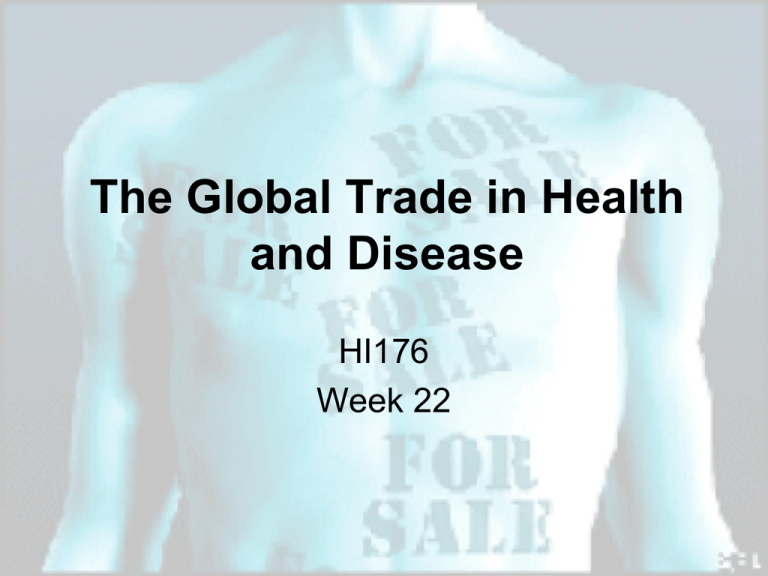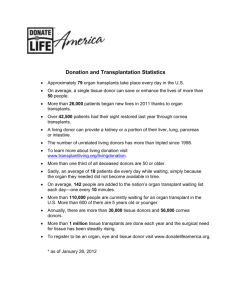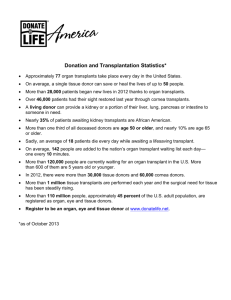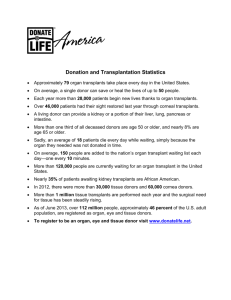The Global Trade in Health and Disease HI176 Week 22
advertisement

The Global Trade in Health and Disease HI176 Week 22 Nazis, Nuremberg & medical ethics • Ravensbrueck Experiments on Sulfanilamide & Other Drugs: no benefit to the experimental subject • Ravensbrueck Experiments on Bone, Muscle, and Nerve Regeneration and Bone Transplantation: no benefit to the experimental subject • Nuremberg Code sets out principle that experimental subject must benefit at least as much as ‘society’ from any experimental risks AND • That subjects must give fully informed consent to the entire experiment So what about the egg, womb and organ trades, then? The body as commodity: is this new? Body as medicinal substance “The English Druggists, especially those of London, sell the Heads or Skulls of the Dead upon which there is a little greenish Moss…” Charas, Pharmacopée Royale Galénique et Chymique 1676, quoted in Pomet, A Compleat History of Druggs 1725 ‘Having been one summer frequently subject to bleed at the nose, and reduced to employ several remedies to check that disorder; that which I found most effectual to staunch the blood was some moss off of a dead man’s skull….’ Robert Boyle, 1644 Portrait of John Tradescant (1608-1662) gardener and proponent of corpse medicines Body as medicinal substance “In Wilts., between Kinnett and Overton … I approach’d workmen digging … ‘making new boundaries to enclose for French grasse or 5 foile’. Said the men, ‘we throw up many bones here…; I quickly perceiv’d they were humane, and came the next day and dugg for them and stored myself with many bushells, of which I made a noble medicine that relieved many of my distressed neighbours.” Letter, Dr. Toope to Mr. Aubrey, 1685, quoted in William Long, ‘Abury Illustrated’ Wiltshire Achaeological and Natural History Magazine iv (1858), p.21 (Now known as West Kennet Long Barrow) ‘Homo Man is not only the Subject of Medicine, but Contributes with his Body to the Materia Medica. Officinal Simples furnish’d from the Parts of the human Body whilst alive are the Hairs, Nails, Saliva, Ear Wax, Sweat, Milk, Menses, Secundines, Urine, Dung, Semen, Blood, the Stones of the Bladder, … and the Mebrane which covers the Head of the Foetus.’ Robert James, Pharmacopoeia Universalis, 1747 Selling and Owning (Living) Bodies: Slavery 'Inventory of Negroes, Cattle, Horses, etc on the estate of Sir James Lowther Bart in Barbados taken this 31st day of December 1766' Congolese Slaves 1904 Selling and Owning (Living) Bodies: ‘Coverture’ • Feature of Anglo-American Law until mid-to late 19th century (upheld by US Supreme Court as late as 1873), granting fathers and husbands the right to control a woman’s property, body, actions and labour. Only widows and unmarried adult women could control their own possessions and actions. Aspects of coverture continued even as late as 1972, when US Supreme Court upheld state laws insisting that women use their husbands’ names on their drivers’ licenses, held their contracts not to be legally binding, etc. • Based in Common Law, conceptions of coverture were spelled out formally by Wm. Blackstone, : ‘By marriage, the husband and wife are one person in law: that is, the very being or legal existence of the woman is suspended during the marriage, or at least is incorporated and consolidated into that of the husband: under whose wing, protection, and cover, she performs every thing…’ See also http://www.time.com/time/magazine/article/0,9171,942533,00.html But also… The body as professional medicine’s raw material Body as medical raw material Up the close and down the stair, In the house with Burke and Hare. Burke’s the butcher, Hare’s the thief Knox, the man who buys the beef. Children's Song Burke’s Notebook (discovered 1829)? This list was printed in an article by FORBES and Co.Printers, 171,Cowgate I. Sept.1826.--Went to lodge with Hare, Tanner's Close, and assisted with the cuddy. Christmas 1827.—Sold the body of Donald the pensioner, in Surgeon Square, for L.7,10. Paid William Hare, Tanner's Close, L4,5. For myself, L.3,5. … May 7 —Sold the old woman, who came to lodge in Tanner's Close, and the child, for £12. Paid for drink, porterage, &c. 7s. Paid William Hare L.5. For myself L6, 13 . … Oct 5.-Sold the girl Paterson for LI0, which was all paid to Harel, he being hard up. 3I- Sold James wilson, or draft Jamie for L15. For myself L7, 10s Body as medical raw material … Body as medical raw material The Immortal Henrietta Lacks Henrietta Lacks entered Johns Hopkins Hospital with a vaginal discharge February 1951. She was diagnosed with cervical cancer, and despite the best treatments then available, she died in October the same year. Her body lives on, in the form of the best known, most widely used, and most profitable cell line in medical history, HeLA. First used to develop Salk’s polio vaccine in 1954, He La cells are now the fundamental substrate for medical research into cancer, AIDS, chemical sensitivity, and a host of other problems. The Lacks family were not informed, did not consent, and have received none of the profits made by ‘manufacturers’ of the HeLA line. As marketable bioproduct… As ‘gift’ As entailing a social/ethical responsibility… Or as an entertainment? And of course, the organ trade… is health for sale? Transplants and the commodification of the body: medical timeline • • • • • • • • • • • • • 1902 Organ transplant proven possible by successful surgical joining of blood vessels 1905 First corneal transplant 1918 Success of blood transfusions (facilitated by blood-tying and anticoagulants) during WWI makes this an everyday aspect of complex surgery 1920s fad for testicular transplants raises first expressions of concern about sale of tissues. 1954 twin makes living donation of kidney to his brother (US; 1st UK 1960) 1962 First cadaver donor kidney transplant (immunosuppresive drugs) 1963 first lung, liver transplants 1967 first heart transplant 1968 National Tissue Typing and Reference Lab established in UK 1968 Harvard Med School publishes influential definition of ‘irreversible coma’ 1968 US Uniform Anatomical Gift Act passed, making it legal to donate deceased person’s organs/tissues for transplantation 1971 Organ Donor cards introduced for kidneys in UK 1972 Organ Matching Service established in UK Medical timeline, cont. • • • • • • • • • • • • • • • 1979 UK transplant service established 1981 Presidential Commission in US adopts ‘whole brain’ inactivity as criteria for ‘brain death’ and Uniform Definition of Death Act 1981 UK kidney donor cards replaced with cards allowing donations of additional tissues 1983 FDA approves Cyclosporin, anti-rejection drug 1984 National Organ Transplant Act, USA forbids sale of living tissues, organs 1986 United Network for Organ Sharing established in USA to ensure equitable distribution of donated organs, set standards for transplant centres 1986 Bristol Eye Bank established (followed by Manchester, etc) 1987 Medicare US begins to pay for heart transplants 1990 Medicare US begins to pay for liver transplants (except in cases of liver cancer) 1993 FDA regulates all tissue banks 1994 UK established national register for organ and tissue donation 1994 National Coalition on Donation partners with National Ad Council to develop pro-donation ad campaign 1996 US Congress legislates to allow information on organ donor cards to be included with US tax return materials 2005 UK transplant merges with NHS Blood Service 2007 First ‘stranger’ or ‘altruistic’ living donor donation allowed in UK Imagining the Organ Trade… Living with the Organ Trade






